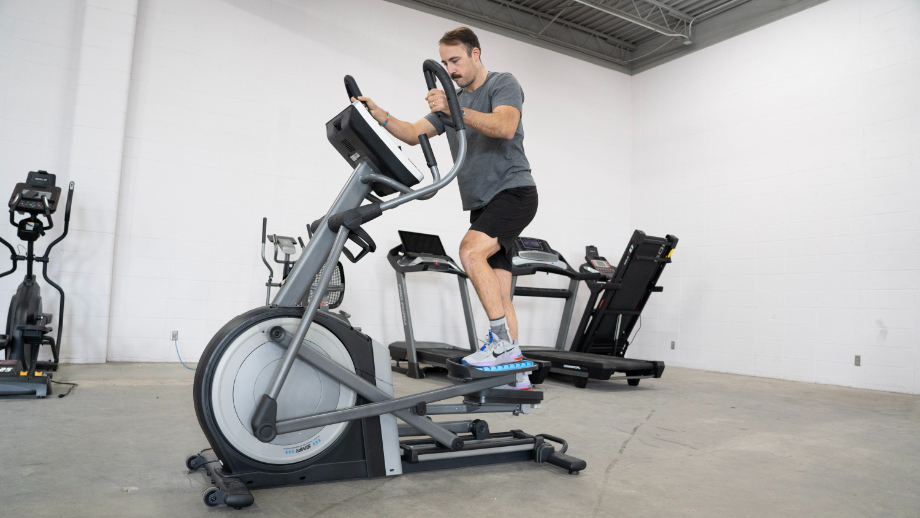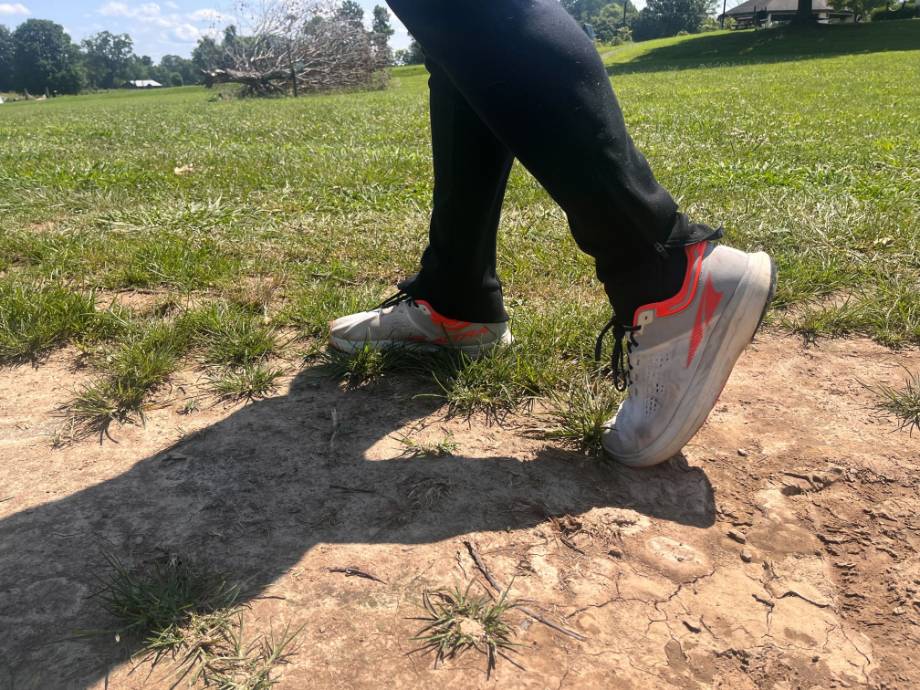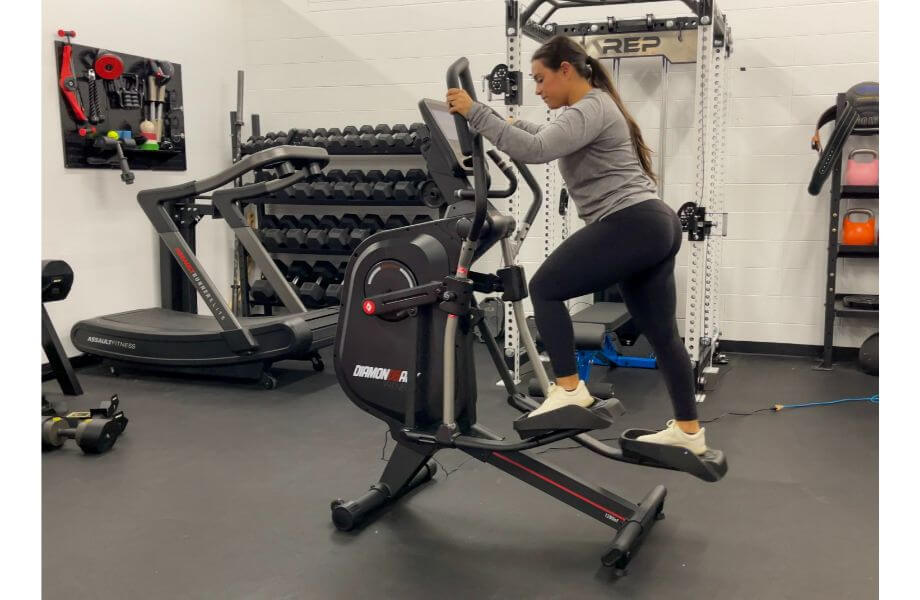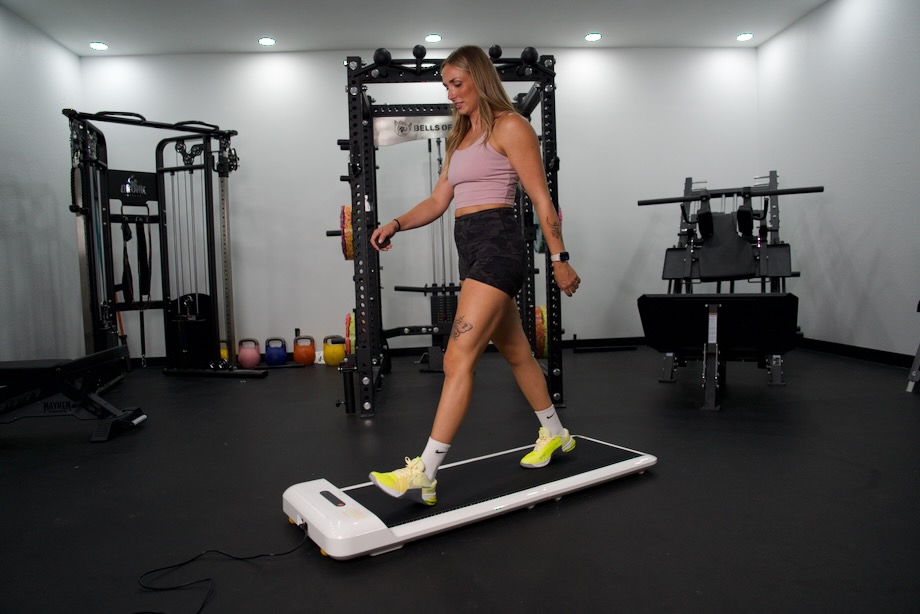We test and review fitness products based on an independent, multi-point methodology. If you use our links to purchase something, we may earn a commission. Read our disclosures.
We all need to move our bodies regularly, but there’s a debate on the most effective method. Today, we’re examining the elliptical vs walking—two excellent forms of low-impact cardio exercise. Which is the better workout? Well, that may depend on your fitness goals, budget, and fitness level.
RELATED: Best Ellipticals For Home
If you’re on a tighter budget, don’t have gym access, or don’t have a ton of cardio fitness equipment available in your home gym, you can’t beat stepping out the door and walking in your neighborhood—it’s free! However, if you’re looking for more of a full-body workout with light strength training, an elliptical can move the major muscle groups while protecting your joints from stress.
Keep reading to see which low-impact exercise fits your workout routine or fitness goals and can offer you a better (and more consistent) cardio session.
Elliptical vs Walking For Weight Loss
Weight loss comes down to being in a calorie deficit, meaning more calories out than in.
According to Harvard Health Publishing¹, a 150-pound person using an elliptical for 30 minutes burns 324 calories. The same 150-pound person on a brisk walk of 4 mph burns 174 calories in 30 minutes. Keep in mind that the more you weigh, the more calories you’ll burn doing most activities. Plus, there are ways to increase the intensity and, therefore, the calorie burn with either type of exercise.

For example, many ellipticals have several resistance levels and sometimes a few incline levels. Increasing resistance and/or incline increases how hard your body has to work. You can also engage in high-intensity interval training (HIIT) using an elliptical machine. While you can increase your walking intensity for weight loss by adding weight, walking faster, or walking uphill, the full-body activation of an elliptical will most likely burn more calories almost every time.
RELATED: Best Ellipticals with Incline
Winner: The elliptical for burning calories at a faster rate.
Elliptical vs Walking For Muscle Gain
Muscle gain requires resistance². The elliptical is the fast and easy answer to a full-body workout and potential muscle gain. Elliptical workouts can also involve your upper body, thanks to the articulating handlebars. Using the pedals and handlebars together activates your whole body, from your upper and lower back and arms to your glutes and leg muscles.
That’s not to say you can’t get a full-body workout while walking, but it’s not built into the exercise like it is on an elliptical. You can add resistance to walking by walking uphill, walking faster, using hand weights or light dumbbells, wearing a weighted vest, or wearing ankle weights.

RELATED: Balancing Cardio and Strength Training
Finally, a full-body workout can strengthen muscle and may build it, especially if you’re an exercise beginner. However, if your goal is muscle gain, you’ll need a well-designed strength training program to progressively overload your muscles, which isn’t what an elliptical is designed to do, nor is it a result of walking.
Winner: Elliptical for activating the upper and lower body.
What Are the Benefits of Elliptical Training?
Ellipticals are more common at gyms than at home, but they offer impressive benefits to protect your health no matter where you use them. The benefits go beyond weight loss, though that’s a pro you don’t want to ignore. If you’ve got achy knees or hips, an elliptical is a cardiovascular workout that won’t leave you sore.
Built-In Programming for Greater Workout Variety
Do you get bored fast when doing cardio? An elliptical machine with built-in programs can add variety to your workouts. Programs typically include a warm-up and then a selection of HIIT programs, hill training, intervals, or workouts that target specific areas of your body, like your glutes, quads, or hamstrings. They may include intervals where you focus solely on your lower body and others where your legs take a break while your upper body does all the work.
RELATED: Elliptical HIIT Workout
Low Joint Stress
A 2021 study³ whose researchers followed 415 higher-weight participants for 48 months found that of the tracked activities, which included everything from racquet sports to running and swimming, elliptical trainers caused the least amount of knee damage. So, if you want to maximize your workout time and save your joints from wear and tear, an elliptical session may be the best cardio workout for you.

Cardiovascular Health and Weight Management
The Centers for Disease Control and Prevention⁴ (CDC) and the American Heart Association⁵ (AHA) recommend 150 minutes of moderate-intensity aerobic exercise or 75 minutes of vigorous aerobic exercise per week for better heart and overall health. A 2019 review article published in Frontiers of Cardiovascular Medicine⁶ states that regular cardio exercise from ellipticals and other types of cardio reduces the risk of cardiovascular disease, reduces blood pressure, improves VO2 max (your body’s oxygen efficiency), and helps control weight.
What Are the Benefits of Walking?
Walking does more than take us from point A to point B. It comes with physical and mental benefits for improved long-term health.
Easily Accessible
Walking is one of the most straightforward and accessible forms of exercise available. All you need are a pair of supportive walking shoes and a safe place to stroll. That could be a treadmill, a neighborhood, or a shopping mall in poor weather.
If you’re new to walking for exercise, take a gradual approach to give your body time to adapt. The goal is 150 moderate-intensity minutes of exercise, but you can gradually work up to that point if needed. If you’re already at 150 minutes per week, try upping your intensity by walking faster, increasing your walking time, or trying more high-impact movements walking uphill or stair climbing.
May Help Prolong Brain Health
Physical activity and brain health are intricately linked. A 2016 symposium review published in the Journal of Physiology⁷ explored how physical activity, specifically easily accessible activities like walking, can maintain brain plasticity and memory while preventing brain deterioration and dementia. Consequently, walking as you age can protect you physically and mentally.

May Help Improve Mood
The same 2016 review highlighted studies that connected physical activity to reduced symptoms of depression. Similarly, a 2019 research report published in the Journal of Geriatric Physical Therapy⁸ found that a short six minutes of walking was enough to improve the mood of older adults. Walking in nature⁹ has also been shown to reduce cortisol levels, the hormone associated with stress.
Elliptical vs Walking: Which Should You Do?
Physical activity is healthy for the mind and body, so you can’t go wrong with regular walking or exercising on an elliptical (or any other cardio machine, for that matter). But if you’re looking for maximum calorie burn in the least amount of time, the elliptical is the more efficient exercise. These machines also offer a full-body workout and varying resistance levels so you can continue challenging yourself as your body adapts.
RELATED: Elliptical vs Treadmill vs Exercise Bike
For those who prefer not to run on a treadmill because of joint issues, an elliptical might be a better investment. But if a new exercise machine isn’t in your budget, walking is the more budget-friendly choice. Walking doesn’t burn as many calories, but you can increase the intensity by walking uphill or accelerating your speed. It’s also simple, inexpensive, and has the potential to get you outside for some much-needed vitamin D.
Elliptical vs Walking: Final Thoughts
Walking and an elliptical are low-impact forms of cardio with fantastic health benefits. However, their differences can make one a better choice for you, depending on your fitness goals. Keep these in mind as you make your choice:
- Ellipticals offer a full-body workout and a higher calorie burn per exercise session.
- Both ellipticals and walking are low-impact and gentle on joints.
- Walking is a money saver because you only need supportive shoes and a safe place to walk.
- Ellipticals typically have several resistance levels and may have incline levels to target different muscle groups.
- Walking can get you outdoors or with friends for additional mental and social benefits.
Elliptical vs Walking: FAQs
Is a mile on the elliptical the same as walking a mile?
Ellipticals calculate mileage in revolutions, so it’s not quite the same as walking a mile. The stride length of the machine will determine how long and how many revolutions it takes to “walk” a mile. As for your exertion level, a mile on an elliptical will probably feel harder because of the full-body activation, which will also help burn more calories per mile.
Should I count the elliptical as “steps?”
While it’s up to you how you count steps, an elliptical’s “steps” are technically revolutions. They’re not the same distance as steps, so the distance you go per revolution may not equal your distance in steps. However, there’s nothing wrong with counting revolutions as steps, as you’re probably burning similar or more calories per revolution than you would per step.
Can I replace walking with the elliptical?
exercises are low-impact and help increase your heart rate. That said, an elliptical offers a more intense workout with readily available resistance adjustments. As long as you regularly use your elliptical, it may replace walking. However, if you’re more likely to be consistent with walking as your main form of exercise, it might be better to stick with walking.
References
- Calories burned in 30 minutes for people of three different weights. (2021). Harvard Health Publishing. Accessed on October 14, 2024. https://www.health.harvard.edu/diet-and-weight-loss/calories-burned-in-30-minutes-for-people-of-three-different-weights
- Lopez, P., et al. (2021). Resistance Training Load Effects on Muscle Hypertrophy and Strength Gain: Systematic Review and Network Meta-analysis. Medicine and Science in Sports and Exercise. 53(6): 1206-1216. https://doi.org/10.1249/MSS.0000000000002585
- Schiro, S. et al. (2022). Impact of different physical activity types on knee joint structural degeneration assessed with 3T MRI in overweight and obese subjects: data from the osteoarthritis initiative. Skeletal Radiology. 50(7): 1427-1440. doi: 10.1007/s00256-020-03642-2. Epub 2021 Jan 6. PMID: 33404670; PMCID: PMC8122031.
- Adult activity: An overview. Centers for Disease Control and Prevention. Accessed on October 15, 2024. https://www.cdc.gov/physical-activity-basics/guidelines/adults.html
- American Heart Association recommendations for physical activity in adults and kids. (2024). American Heart Association. https://www.heart.org/en/healthy-living/fitness/fitness-basics/aha-recs-for-physical-activity-in-adults
- Pinckard, K., et al. (2019). Effects of exercise to improve cardiovascular health. Frontiers in Cardiovascular Medicine. 6. https://doi.org/10.3389/fcvm.2019.00069
- Jackson, P.A., et al. (2016). Promoting brain health through exercise and diet in older adults: A physiological perspective. The Journal of Physiology. 594(4): 4495-4498. doi: 10.1113/JP271270. Epub 2016 Jan 6. PMID: 27524792; PMCID: PMC4983622.
- Boolani, A., et al. (2019). Six minutes of physical activity improves mood in older adults: A pilot study. Journal of Geriatric Physical Therapy. 44(1): 18-24. DOI: 10.1519/JPT.0000000000000233
- Olafsdotter, G., et al. (2018). Health benefits of walking in nature: A randomized controlled study under conditions of real-life stress. Environment and Behavior.52(3).
